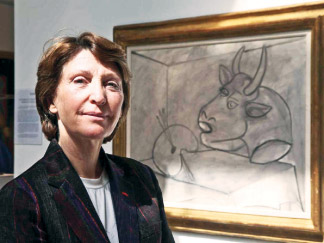|
Craft India:
Richness in each frame of painting
by Sabitha Radhakrishna
In many homes in India, you might have seen pictures based on
religious themes, covered in gold, and stones. These are called
Thanjavur paintings.
|

Finishing touches to a Tanjavur painting. |
It is figured that these paintings originated in the middle of the 18
Century and were crafted up to the middle of the 19 Century. They were
painted on wood, glass, mica, ivory and even on walls. The artists were
Vaishnavites, (worshippers of Vishnu) so they painted images of Rama,
Krishna, Lakshmi, Narasimha and so on. The Shaivites, worshippers of
Shiva, introduced Ganesha, Nataraja, Muruga, Parvati and other deities.
Historians credit the art of this ornate form of Thanjavur painting to
Serfoji Maharaja of Thanjavur.
A Thanjavur painting is generally made on a canvas pasted over a thin
plank of seasoned wood with Arabic gum. The canvas is then evenly coated
with a paste of French chalk (Gopi) or powdered limestone and a binding
medium and dried.
The surface has to be perfectly smooth for further work. Tamarind
paste is also used as an adhesive.The artist then draws the outline on
the prepared surface. Originally tamarind twigs were used to draw the
outlines, by charring the ends. Today of course, modern drawing tools
are available. Even ready stencils are available to make the work
easier.
Prepared bases, including pasted canvases with the drawing, reduce
the work.
Only vegetable dyes, made from flowers, leaves, barks of trees were
used. But since they are difficult to prepare, chemical dyes have
replaced them. The colours were filled by using brushes made of
squirrel's hair!
A paste, made of limestone powder and a binding medium called sukkan
or makku, is used for creating the Gesso work which means certain areas
are padded to give a two dimensional effect. Gold leaf foil is also used
and gems of varied hues were inlaid in selected areas like pillars,
arches, thrones, dresses and so on.
Finally, colours are applied on the sketch.Stones are set in the
jewellery worn by the deities, and even these were semi precious stones
- rarely used today. Since so much of detailing goes into the making of
a Thanjavur painting, it is priced high.
Sometimes you see the main deity being larger than the other figures
in the painting. It is because the main deity is more important as in
the paintings of Krishna which are popular.
- The Hindu |

